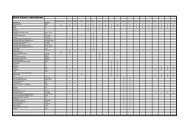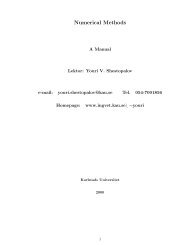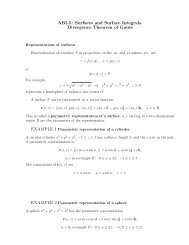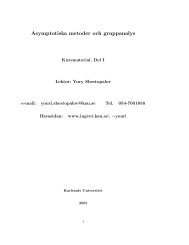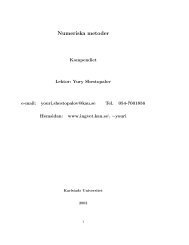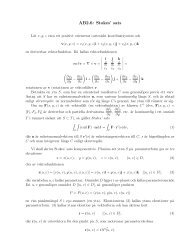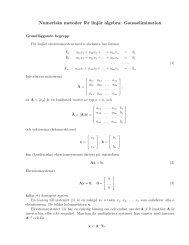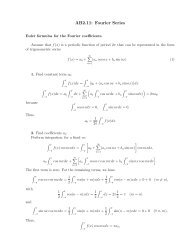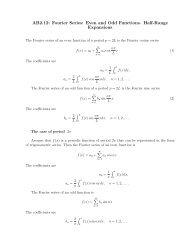You also want an ePaper? Increase the reach of your titles
YUMPU automatically turns print PDFs into web optimized ePapers that Google loves.
so thatanda 11 =a 12 =a 21 =a 22 =f 1 =f 2 =∫ 10∫ 10∫ 10∫ 10∫ 10∫ 10b 1 (y)a 1 (y)dy =b 1 (y)a 2 (y)dy =b 2 (y)a 1 (y)dy =b 2 (y)a 2 (y)dy =b 1 (y)f(y)dy =b 2 (y)f(y)dy =∫ 10∫ 10∫ 10∫ 10∫ 10∫ 10ydy = 1 2 ,dy = 1, (140)y 2 dy = 1 3 ,ydy = 1 2 ,f(y)dy, (141)yf(y)dy,and changing the order of summation and integration, we rewrite the corresponding equation(133) asor, explicitly,2∑c i − λ a ik c k = f i , i = 1, 2, (142)k=1(1 − λ/2)c 1 − λc 2 = f 1 ,−(λ/3)c 1 + (1 − λ/2)c 2 = f 2 ,which is a linear equation system of order 2 with respect to unknowns c i .The determinant of system (143) is1 − λ/2 −λD(λ) =∣ −λ/3 1 − λ/2 ∣ = 1 + λ2 /4 − λ − λ 2 /3 = 1 − λ − λ 2 /12 = − 1 12 (λ2 + 12λ − 12)(143)is a polynomial of order 2. (D(λ) is not identically, and D(0) = 1). There exist not more than2 different numbers λ = λ ∗ k such that D(λ ∗ k) = 0. Here there are exactly two such numbers; theyareλ ∗ 1 = −6 + 4 √ 3, (144)λ ∗ 2 = −6 − 4 √ 3.If λ ≠ λ ∗ k, then system (143) and IE (137) are uniquely solvable.To find the solution of system (143) apply Cramer’s rule and calculate the determinants ofsystem (143)fD 1 = 1 −λ∣ f 2 1 − λ/2 ∣ = f 1(1 − λ/2) + f 2 λ == (1 − λ/2)∫ 10f(y)dy + λ∫ 10yf(y)dy =29∫ 10[(1 − λ/2) + yλ]f(y)dy, (145)



